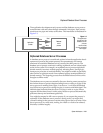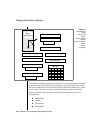
2-36 IBM Informix OnLine Database Server Administrator’s Guide
Shared Memory and Process Communication
Shared Memory and Process Communication
Shared memory refers to the use of the same memory segments by more than
one OnLine user process, enabling interprocess communication. Figure 2-4
on page 2-37 shows how multiple user processes can communicate by way of
shared memory.
Interprocess communication via shared memory has the following advan-
tages over systems in which server processes each maintain their own private
copy of data:
■ Disk I/O is reduced because buffers, which are managed as a
common pool, are flushed on a system-wide basis instead of a per-
process basis.
■ Execution time is reduced because only one copy of a data or index
page is maintained in shared memory. Processes do not need to
reread shared-memory buffers to ensure that their data is current.
Often, processes do not need to read a page in from disk if the page
is already in shared memory as a result of an earlier query.


















